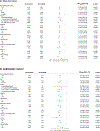Postdiagnosis Aspirin Use Associated With Decreased Biliary Tract Cancer-Specific Mortality in a Large Nationwide Cohort
- PMID: 33942350
- PMCID: PMC12323429
- DOI: 10.1002/hep.31879
Postdiagnosis Aspirin Use Associated With Decreased Biliary Tract Cancer-Specific Mortality in a Large Nationwide Cohort
Abstract
Background and aims: Biliary tract cancer (BTC) is rare and has limited treatment options. We aimed to examine aspirin use on cancer-specific survival in various BTC subtypes, including gallbladder cancer, ampulla of Vater cancer, and cholangiocarcinoma.
Approach and results: Nationwide prospective cohort of newly diagnosed BTC between 2007 and 2015 were included and followed until December 31, 2017. Three nationwide databases, namely the Cancer Registration, National Health Insurance, and Death Certification System, were used for computerized data linkage. Aspirin use was defined as one or more prescriptions, and the maximum defined daily dose was used to evaluate the dose-response relationship. Cox's proportional hazards models were applied for estimating HRs and 95% CIs. Analyses accounted for competing risk of cardiovascular deaths, and landmark analyses to avoid immortal time bias were performed. In total, 2,519 of patients with BTC were exposed to aspirin after their diagnosis (15.7%). After a mean follow-up of 1.59 years, the 5-year survival rate was 27.4%. The multivariate-adjusted HR for postdiagnosis aspirin users, as compared with nonusers, was 0.55 (95% CI: 0.51 to 0.58) for BTC-specific death. Adjusted HRs for BTC-specific death were 0.53 (95% CI: 0.48 to 0.59) and 0.42 (95% CI: 0.31 to 0.58) for ≤ 1 and > 1 maximum defined daily dose, respectively, and showed a dose-response trend (P < 0.001; nonusers as a reference). Cancer-specific mortality was lower with postdiagnosis aspirin use in patients with all major BTC subtypes.
Conclusions: The nationwide study revealed that postdiagnosis aspirin use was associated with improved BTC-specific mortality of various subtypes. The findings suggest that additional randomized trials are required to investigate aspirin's efficacy in BTC.
© 2021 by the American Association for the Study of Liver Diseases.
Conflict of interest statement
Figures


Comment in
-
REPLY.Hepatology. 2021 Nov;74(5):2925-2926. doi: 10.1002/hep.32051. Epub 2021 Sep 15. Hepatology. 2021. PMID: 34240448 Free PMC article. No abstract available.
-
Letter to the Editor: Is Aspirin a Drug or Just a Marker for Biliary Cancer?Hepatology. 2021 Nov;74(5):2924. doi: 10.1002/hep.32052. Epub 2021 Aug 26. Hepatology. 2021. PMID: 34242426 No abstract available.
-
Letter to the Editor: Postdiagnosis Aspirin Use Associated With Decreased Biliary Tract Cancer?Hepatology. 2022 Feb;75(2):494-495. doi: 10.1002/hep.32170. Epub 2021 Dec 6. Hepatology. 2022. PMID: 34555199 No abstract available.
References
-
- Global Burden of Disease Cancer C, Fitzmaurice C, Abate D, Abbasi N, Abbastabar H, Abd-Allah F, et al. Global, regional, and national cancer incidence, mortality, years of life lost, years lived with disability, and disability-adjusted life-years for 29 cancer groups, 1990 to 2017: a systematic analysis for the global burden of disease study. JAMA Oncol 2019;5(12):1749–1768. - PMC - PubMed
-
- Rothwell PM, Wilson M, Elwin CE, Norrving B, Algra A, Warlow CP, et al. Long-term effect of aspirin on colorectal cancer incidence and mortality: 20-year follow-up of five randomised trials. Lancet 2010;376(9754):1741–1750. - PubMed
Publication types
MeSH terms
Substances
Grants and funding
LinkOut - more resources
Full Text Sources
Other Literature Sources
Medical

